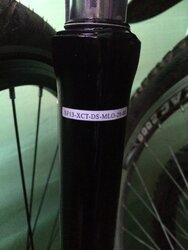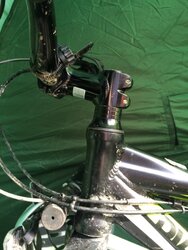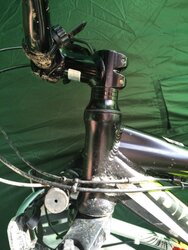Your fork is a Suntour XCT MLO 29 80. It has a coil spring, is made to fit 29er wheels, and has 80mm max travel. The MLO means "mechanical lockout" . The tech docs show it has no compression adjustment or damping and uses a coil spring.
Fork configuration is a bit of a minefield but here's a glossary style explanation:
Wheel standard: 29er, the fork will only fit 29er wheels, 27.5 will fit 27.5 and sometimes 26ers, 26" will fit 26 inch wheels and sometimes 27.5/650b. Your fork is for 29" wheels
Travel: The amount of suspension movement the fork will allow. Usually measured in millimetres the fork compresses by sliding the lower leg up the stanchion (that's the shiny leg) Your fork has 80mm of suspension travel max.
Spring type. Budget forks use a metal coil spring to allow compression movement. Yours is a coil spring. The rate at which a fork can compress depends on the spring strength. This can be adjusted either using a preload system, usually by winding an adjuster which twists and "preloads" the spring, making it stiffer or softer, or by changing the spring either for a stiffer or a more flexible one.
Some forks use an air spring, which is an air-filled airtight chamber with a piston assembly, and spring compression can be adjusted by adding or reducing air to the air chamber via a valve.
Compression rate. Adjustable compression rate is a way to tune a fork to react to different type of suspension movements and different riding situations/rider preference. You tend to find this sort of adjustability in higher budget forks. Your Suntour is not adjustable for compression rate as it stands, although the preload function might affect the way it compresses at the extreme ends of the suspension movement.
Suspension damping. When a fork spring compresses it wants to go back to where it started. At the budget end of forks you find little or no damping, so when you hit a bump the fork compresses then bounces back up at exactly the same speed as it compressed. This means that it absorbs bumps in the trail, but can bounce you back up again immediately afterwards. This means that the tyre doesn't remain in contact with the trail surface, and the danger is that the bike will have little grip, or may even spit you off on big bumps. Fine on a canal towpath, but difficult to live with on anything rocky or successive bumps. The most common type of damping is hydraulic damping- a system of valves in an oil filled chamber that allows the fork to compress quickly, but slows and smooths its return rate. Your Suntour does not have any damping system.
Lockout A big sales point for some folk, and a mixed bag in terms of usefulness. The MLO in your fork label means "mechanical lock out". A dial on the fork leg means you can stop the fork from responding to bumps, and make the fork rigid. Other lockout functions use the more sophisticated compression and damping systems to ramp up the compression rate so far that the fork barely reacts to little hits, thereby effectively "locking" the fork. Don't get hung up on lockout types, and in my personal opinion remote lockout levers on the bars are a bit "Emporor's New Clothes"..... It's easy enough to turn a fork top dial, and I find the remotes pretty unreliable.
So, that's how your current fork functions. The fit depends on the steerer, head tube of your bike, and the headset.
The steerer's the metal tube which fits inside the head tube of your bike. There are now two common standards, straight and tapered. Straight steerers are 1 1/8" in diameter, and tapered are 1 1/8" through the main length, but flare to 1 1/2" at the crown (bottom of the steerer tube). If you have a straight steerer you can swap for another fork with a straight steerer without changing anything else, as long as the steerer is long enough.
Head tube length varies from bike to bike and size to size. Basically the steerer needs to be long enough to pass through the headtube and the headset, then allow enough extra length to fit the stem clamp, a few spacers and to allow the top cap to load the headset bearings. This is a simple measurement on your current bike... basically run a tape measure from the top cap where it sits on top of the stem or topmost spacer, and measure to the top of the fork crown. If you aren't changing anything else, the steerer of a replacement fork needs to be at least this long. If it's longer it can be cut to fit, but any shorter and you'll need to calculate whether you can lose spacers and or stem stack height to fit it.
Finally, axle standards.
Three main types ox axle standards, and these are fixed on the fork. It will either fit a 9mm QR axle, or a 15mm maxle, or an older type 20mm QR or bolt-through. I suspect yours will be 9mm QR. You can't mix them without changing the fork lowers, or using wheel adapters on some hubs.



